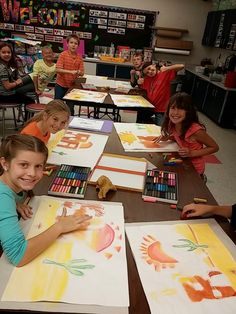
The Arts in Fourth Grade
The integration of arts education in the fourth-grade curriculum plays a crucial role in fostering creativity, critical thinking, and emotional expression among students. At this age, typically around 9-10 years old, children are developing more sophisticated cognitive abilities and social awareness, making it an ideal time to deepen their engagement with various art forms.
Visual arts in fourth grade often focus on expanding students’ technical skills while encouraging personal expression. Children at this level may learn more advanced drawing techniques, such as perspective and shading, and explore different mediums like watercolors, acrylics, or clay sculpture. Projects might include creating self-portraits, landscapes, or abstract compositions that allow students to experiment with color theory and composition principles.
Music education in fourth grade typically builds upon earlier foundations. Students may begin learning to read musical notation more fluently and could start playing instruments like recorders or participate in choir. Music classes often incorporate elements of music history and appreciation, introducing students to various genres and cultural traditions. This exposure helps broaden their understanding of music as a universal language and a reflection of diverse societies.
Drama and theater arts provide fourth-graders with opportunities to develop public speaking skills, emotional intelligence, and teamwork. Activities might include role-playing exercises, short skits, or even putting on a class play. These experiences help students build confidence, empathy, and the ability to express themselves verbally and non-verbally.
Dance education at this level can include learning simple choreographies, exploring different dance styles from around the world, and creating original movements. Dance not only promotes physical fitness and coordination but also serves as a form of non-verbal communication and cultural expression.
Integrating technology into arts education becomes more prominent in fourth grade. Students might use digital tools to create artwork, compose music, or edit videos. This intersection of technology and art prepares them for the increasingly digital world while still fostering creativity and personal expression.
The arts curriculum in fourth grade often incorporates cross-disciplinary connections. For example, students might create artwork inspired by a historical event they’re studying in social studies, or write and perform a song about a scientific concept. These interdisciplinary approaches help students see the relevance of art in other areas of learning and life.
Art appreciation and criticism also become more sophisticated at this grade level. Students are encouraged to analyze artworks, discussing elements like color, form, and technique, as well as the emotions or ideas conveyed. This develops critical thinking skills and the ability to interpret visual information.
Cultural diversity is often a key theme in fourth-grade arts education. Students may explore art forms from different cultures, learning about traditions, symbols, and the historical context of various artistic expressions. This fosters cultural awareness and respect for diversity.
The arts in fourth grade also serve as a valuable outlet for emotional expression and stress relief. As academic pressures increase, having creative outlets becomes increasingly important for maintaining emotional well-being and a balanced educational experience.
Assessment in arts education at this level typically focuses on effort, creativity, and personal growth rather than strict technical proficiency. This approach encourages risk-taking and experimentation, vital components of artistic development.
Challenges in arts education for fourth grade often include limited resources and time constraints within the school curriculum. However, many educators and schools recognize the value of arts education and strive to integrate it across various subjects.
The arts in fourth grade lay a foundation for lifelong appreciation and participation in creative activities. Whether students pursue the arts professionally or as a hobby, the skills and experiences gained at this age contribute significantly to their overall development and quality of life.




